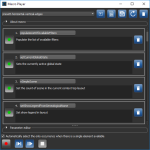About the Macro Player
You can record macros in Dragonfly to automate frequently used commands or processes, which can help you save time by streamlining repetitive tasks. After you record a macro, you can play it back to perform all of the steps in the macro with a single action, unless a user input is required.
Macro Player dialog
|
|
Icon |
Description |
|---|---|---|
|
New Macro |
|
Creates a new macro file. After you click New Macro, you can start recording immediately or choose to click the Record button to start. |
|
View File |
|
Opens the current macro file. Macro files are written in Python and can be viewed and edited in a simple text editor or with a developer application such as PyCharm. |
|
Save |
|
Saves any changes you made to the macro you are playing. |
|
Reload |
|
Reloads the selected macro. You can reload a macro to discard any changes you made while editing the macro in the Macro Player dialog. Reloading a macro will also apply any changes you made to the macro file externally. For example, to the Python file itself. |
|
Delete |
|
Deletes the selected macro or step. |
|
Execute |
|
When a macro step is set to Execute, the step will be executed automatically. |
|
Pause |
|
When a macro step is set to Pause, the macro will stop at the paused step and wait for a user input. |
|
Skip |
|
When a macro step is set to Skip, the macro will skip the step and continue playback. |
|
Record |
|
Begins recording. The Record option changes to Pause as soon as you begin recording. |
|
Pause |
|
Pauses recording. The Pause option changes to Record as soon as you pause recording. |
|
Play Single Step |
|
Plays the macro step-by-step. |
|
Play All |
|
Plays the macro, either to the end or to point that a user input is required. |
|
Stop |
|
Stops playback. |
Following are the primary tasks that you can perform when using macros:
- Record a Macro… For most tasks that apply to Dragonfly, you can record macros to use in your image processing and analysis workflows (see Recording Macros).
- Play Back a Macro… You can execute or play back the macros you have recorded (see Playing Macros).












